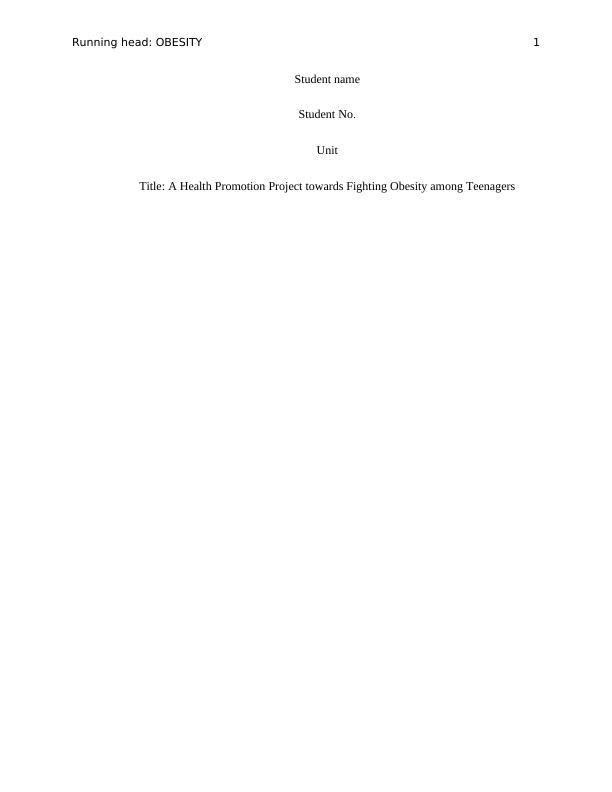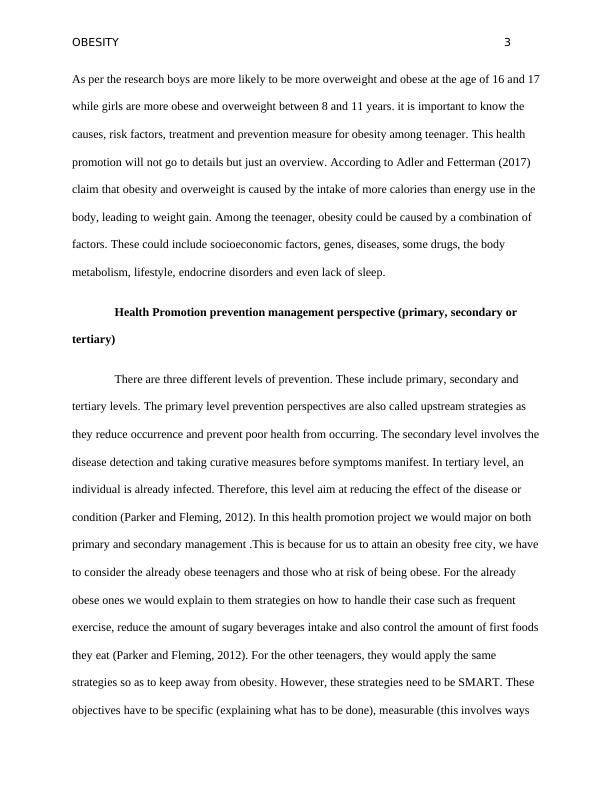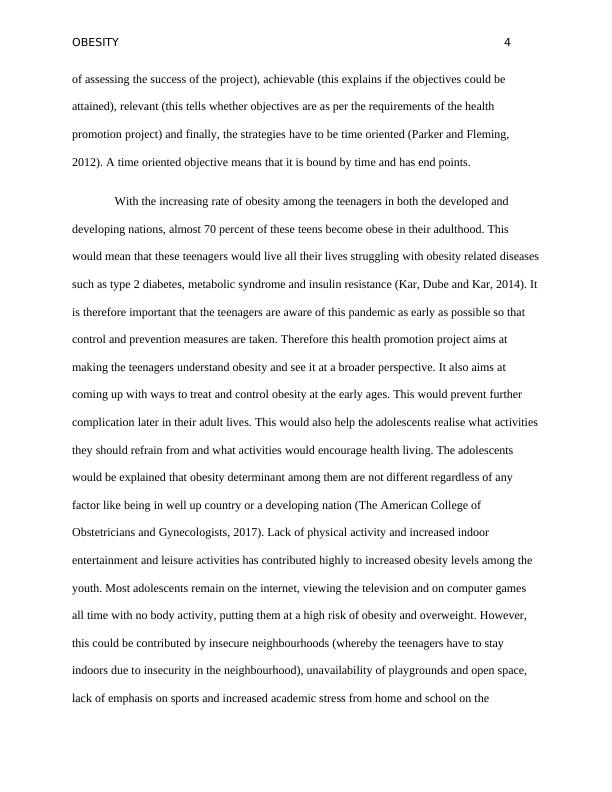ASSIGNMENTS ON OBESITY DISEASE
Presents an original community focussed public health promotion prevention or management plan.
13 Pages3631 Words22 Views
Added on 2022-09-27
ASSIGNMENTS ON OBESITY DISEASE
Presents an original community focussed public health promotion prevention or management plan.
Added on 2022-09-27
ShareRelated Documents
Running head: OBESITY 1
Student name
Student No.
Unit
Title: A Health Promotion Project towards Fighting Obesity among Teenagers
Student name
Student No.
Unit
Title: A Health Promotion Project towards Fighting Obesity among Teenagers

OBESITY 2
Introduction
The current world disease profile has struck the attention of policy makers and health
care professionals. Cardiovascular diseases, diabetes and obesity are the most rising disease
epidemics in the society today. Among these diseases obesity has caused more serious public
harm, with it contributing to more than 2.6 million deaths per year. Other than being a risk factor
for cardiovascular disease, obesity is also linked with high morbidity and mortality rates, as well
as low life expectancy. This century has been faced with increased health care costs due to
increased cases of obesity and other related complications among the children and adolescents
(Alberga, Sigal, Goldfield, Prud'Homme, & Kenny, 2012). These diseases are affecting both
developing and developed nations, without discriminating based on socio-economic status, sex,
ethnicity or age. More than 22 million children below the age of 5 years is obese and among
every 10 children one is overweight. This project will entirely major on obesity among the
adolescent or teenagers (11-19 years old) both boys and girls at Sidney.
Health promotion importance and target group
Obesity and overweigh among children and adolescents are described based on age and
sex specific nomograms for the body mass index. When a teenager’s BMI equals or exceeds the
age gender specific 95th percentile, then the teen is said to be obese. When the BMI exceeds or
equals to 85th but less than 95th percentiles, the adolescent is described as overweight and is at
risk of comorbid diseases related to obesity (Raj and Kumar, 2010). Research by the Australian
Institute of health and Welfare (2017) conducted in 2014-15 showed that 27 percent of teenagers
aged between 5-17 years were obese and overweight, with 20 percent being overweight and 7
percent being obese. Boys and girls had almost the same proportion of obesity and overweight.
Introduction
The current world disease profile has struck the attention of policy makers and health
care professionals. Cardiovascular diseases, diabetes and obesity are the most rising disease
epidemics in the society today. Among these diseases obesity has caused more serious public
harm, with it contributing to more than 2.6 million deaths per year. Other than being a risk factor
for cardiovascular disease, obesity is also linked with high morbidity and mortality rates, as well
as low life expectancy. This century has been faced with increased health care costs due to
increased cases of obesity and other related complications among the children and adolescents
(Alberga, Sigal, Goldfield, Prud'Homme, & Kenny, 2012). These diseases are affecting both
developing and developed nations, without discriminating based on socio-economic status, sex,
ethnicity or age. More than 22 million children below the age of 5 years is obese and among
every 10 children one is overweight. This project will entirely major on obesity among the
adolescent or teenagers (11-19 years old) both boys and girls at Sidney.
Health promotion importance and target group
Obesity and overweigh among children and adolescents are described based on age and
sex specific nomograms for the body mass index. When a teenager’s BMI equals or exceeds the
age gender specific 95th percentile, then the teen is said to be obese. When the BMI exceeds or
equals to 85th but less than 95th percentiles, the adolescent is described as overweight and is at
risk of comorbid diseases related to obesity (Raj and Kumar, 2010). Research by the Australian
Institute of health and Welfare (2017) conducted in 2014-15 showed that 27 percent of teenagers
aged between 5-17 years were obese and overweight, with 20 percent being overweight and 7
percent being obese. Boys and girls had almost the same proportion of obesity and overweight.

OBESITY 3
As per the research boys are more likely to be more overweight and obese at the age of 16 and 17
while girls are more obese and overweight between 8 and 11 years. it is important to know the
causes, risk factors, treatment and prevention measure for obesity among teenager. This health
promotion will not go to details but just an overview. According to Adler and Fetterman (2017)
claim that obesity and overweight is caused by the intake of more calories than energy use in the
body, leading to weight gain. Among the teenager, obesity could be caused by a combination of
factors. These could include socioeconomic factors, genes, diseases, some drugs, the body
metabolism, lifestyle, endocrine disorders and even lack of sleep.
Health Promotion prevention management perspective (primary, secondary or
tertiary)
There are three different levels of prevention. These include primary, secondary and
tertiary levels. The primary level prevention perspectives are also called upstream strategies as
they reduce occurrence and prevent poor health from occurring. The secondary level involves the
disease detection and taking curative measures before symptoms manifest. In tertiary level, an
individual is already infected. Therefore, this level aim at reducing the effect of the disease or
condition (Parker and Fleming, 2012). In this health promotion project we would major on both
primary and secondary management .This is because for us to attain an obesity free city, we have
to consider the already obese teenagers and those who at risk of being obese. For the already
obese ones we would explain to them strategies on how to handle their case such as frequent
exercise, reduce the amount of sugary beverages intake and also control the amount of first foods
they eat (Parker and Fleming, 2012). For the other teenagers, they would apply the same
strategies so as to keep away from obesity. However, these strategies need to be SMART. These
objectives have to be specific (explaining what has to be done), measurable (this involves ways
As per the research boys are more likely to be more overweight and obese at the age of 16 and 17
while girls are more obese and overweight between 8 and 11 years. it is important to know the
causes, risk factors, treatment and prevention measure for obesity among teenager. This health
promotion will not go to details but just an overview. According to Adler and Fetterman (2017)
claim that obesity and overweight is caused by the intake of more calories than energy use in the
body, leading to weight gain. Among the teenager, obesity could be caused by a combination of
factors. These could include socioeconomic factors, genes, diseases, some drugs, the body
metabolism, lifestyle, endocrine disorders and even lack of sleep.
Health Promotion prevention management perspective (primary, secondary or
tertiary)
There are three different levels of prevention. These include primary, secondary and
tertiary levels. The primary level prevention perspectives are also called upstream strategies as
they reduce occurrence and prevent poor health from occurring. The secondary level involves the
disease detection and taking curative measures before symptoms manifest. In tertiary level, an
individual is already infected. Therefore, this level aim at reducing the effect of the disease or
condition (Parker and Fleming, 2012). In this health promotion project we would major on both
primary and secondary management .This is because for us to attain an obesity free city, we have
to consider the already obese teenagers and those who at risk of being obese. For the already
obese ones we would explain to them strategies on how to handle their case such as frequent
exercise, reduce the amount of sugary beverages intake and also control the amount of first foods
they eat (Parker and Fleming, 2012). For the other teenagers, they would apply the same
strategies so as to keep away from obesity. However, these strategies need to be SMART. These
objectives have to be specific (explaining what has to be done), measurable (this involves ways

OBESITY 4
of assessing the success of the project), achievable (this explains if the objectives could be
attained), relevant (this tells whether objectives are as per the requirements of the health
promotion project) and finally, the strategies have to be time oriented (Parker and Fleming,
2012). A time oriented objective means that it is bound by time and has end points.
With the increasing rate of obesity among the teenagers in both the developed and
developing nations, almost 70 percent of these teens become obese in their adulthood. This
would mean that these teenagers would live all their lives struggling with obesity related diseases
such as type 2 diabetes, metabolic syndrome and insulin resistance (Kar, Dube and Kar, 2014). It
is therefore important that the teenagers are aware of this pandemic as early as possible so that
control and prevention measures are taken. Therefore this health promotion project aims at
making the teenagers understand obesity and see it at a broader perspective. It also aims at
coming up with ways to treat and control obesity at the early ages. This would prevent further
complication later in their adult lives. This would also help the adolescents realise what activities
they should refrain from and what activities would encourage health living. The adolescents
would be explained that obesity determinant among them are not different regardless of any
factor like being in well up country or a developing nation (The American College of
Obstetricians and Gynecologists, 2017). Lack of physical activity and increased indoor
entertainment and leisure activities has contributed highly to increased obesity levels among the
youth. Most adolescents remain on the internet, viewing the television and on computer games
all time with no body activity, putting them at a high risk of obesity and overweight. However,
this could be contributed by insecure neighbourhoods (whereby the teenagers have to stay
indoors due to insecurity in the neighbourhood), unavailability of playgrounds and open space,
lack of emphasis on sports and increased academic stress from home and school on the
of assessing the success of the project), achievable (this explains if the objectives could be
attained), relevant (this tells whether objectives are as per the requirements of the health
promotion project) and finally, the strategies have to be time oriented (Parker and Fleming,
2012). A time oriented objective means that it is bound by time and has end points.
With the increasing rate of obesity among the teenagers in both the developed and
developing nations, almost 70 percent of these teens become obese in their adulthood. This
would mean that these teenagers would live all their lives struggling with obesity related diseases
such as type 2 diabetes, metabolic syndrome and insulin resistance (Kar, Dube and Kar, 2014). It
is therefore important that the teenagers are aware of this pandemic as early as possible so that
control and prevention measures are taken. Therefore this health promotion project aims at
making the teenagers understand obesity and see it at a broader perspective. It also aims at
coming up with ways to treat and control obesity at the early ages. This would prevent further
complication later in their adult lives. This would also help the adolescents realise what activities
they should refrain from and what activities would encourage health living. The adolescents
would be explained that obesity determinant among them are not different regardless of any
factor like being in well up country or a developing nation (The American College of
Obstetricians and Gynecologists, 2017). Lack of physical activity and increased indoor
entertainment and leisure activities has contributed highly to increased obesity levels among the
youth. Most adolescents remain on the internet, viewing the television and on computer games
all time with no body activity, putting them at a high risk of obesity and overweight. However,
this could be contributed by insecure neighbourhoods (whereby the teenagers have to stay
indoors due to insecurity in the neighbourhood), unavailability of playgrounds and open space,
lack of emphasis on sports and increased academic stress from home and school on the

End of preview
Want to access all the pages? Upload your documents or become a member.
Related Documents
Concept Map | Community Health Promotionlg...
|10
|2407
|79
A Survey on the Impact of Poor Nutrition and Physical Activity on Childhood Obesitylg...
|4
|1785
|427
Childhood Obesity Facts & Statisticslg...
|4
|2365
|478
Disease Prevention and Management Assignment 2022lg...
|16
|4469
|19
Obesity in Children | ENG 122lg...
|5
|1576
|125
A Report on Childhood Obesitylg...
|9
|1533
|25
